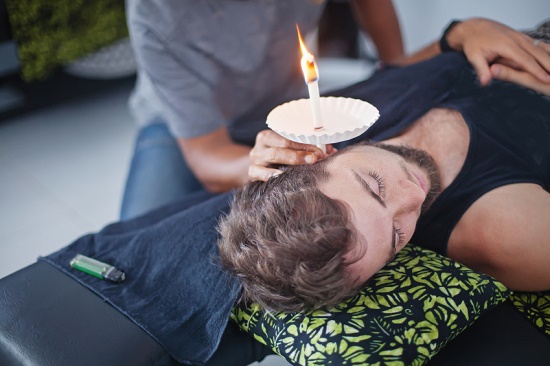
Our ears could very well be our most abused body part. We pierce them, subject them to deafening noise, force cotton swabs inside them, and burn them with ear candling. Despite supplying us with one of our most crucial senses, we rarely give our ears, or our hearing, much gratitude or consideration.
That is, right until there are problems. After that, we grasp just how crucial healthy hearing really is—and how we should have learned proper ear care sooner. The secret is to recognize this before the damage is done.
If you desire to avoid problems and preserve your hearing, stay away from these 4 dangerous practices.
1. Ear Candling
Ear candling is a technique of removing earwax, and also, as one researcher put it, “the triumph of ignorance over science.”
Here’s how ear candling is accomplished. One end of a slim tube made of cotton and beeswax is placed into the ear. The other end is set on fire, which purportedly creates a vacuum of negative pressure that draws earwax up into the tube.
Except that it doesn’t, for two reasons.
First, the ear candle doesn’t create negative pressure. As explained by Lisa M.L. Dryer, MD, earwax is sticky, so even if negative pressure was created, the pressure needed to suck up earwax would end up rupturing the eardrum.
Second, while the wax and ash resemble earwax, no earwax is actually found within the ear candle following the treatment. Clinical psychologist Philip Kaushall tested this by burning some ear candles the standard way and burning other candles without placing them into the ear. The residue was exactly the same for both groups.
Ear candling is also harmful and is fervently opposed by both the FDA and the American Academy of Otolaryngology (physicians specializing in the ear, nose, and throat), if you require any other reasons not to do it.
2. Using cotton swabs to clean your ears
We’ve covered this in other articles, but inserting any foreign object into your ear simply presses the earwax against the eardrum, creating an impaction and potentially a ruptured eardrum and hearing loss.
Your earwax is made up of beneficial antibacterial and lubricating properties, and is naturally expelled by the regular movements of the jaw (from speaking and chewing). All that’s required from you is normal showering, or, if you do have problems with excess earwax, a professional cleaning from your hearing practitioner.
But don’t take our word for it: just take a look at the back of the packaging of any box of cotton swabs. You’ll find a warning from the manufacturers themselves advising you to not enter the ear canal with their product.
3. Listening to exceedingly loud music
Our ears are just not equipped to handle the loud sounds we’ve learned how to create. In fact, any sound louder than 85 decibels has the potential to create irreversible hearing loss.
How loud is 85 decibels?
An ordinary conversation registers at about 60, while a rock performance registers at over 100. But here’s the thing about the decibel scale: it’s logarithmic, not linear. Which means the jump from 60 to 100 does not make the rock concert twice as loud, it makes it about 16 times as loud!
Similarly, many earbuds can achieve a similar output of 100 decibels or greater—all from inside of the ear canal. It’s no real shock then that this can create irreparable injury.
If you would like to conserve your hearing, ensure that you wear earplugs to live shows (and while at work if needed) and maintain your portable music player volume at about 60 percent or less of its max volume (with a 60 minute listening time limit). It may not be cool to wear earplugs to your next concert, but untimely hearing loss is not much cooler.
4. Disregarding the signs of hearing loss
Last, we have the unsettling fact that individuals have the tendency to wait almost 10 years from the start of symptoms before seeking help for their hearing loss.
That indicates two things: 1) people needlessly suffer the negative effects of hearing loss for 10 years, and 2) they render their hearing loss a great deal harder to treat.
It’s true that hearing aids are not perfect, but it’s also true that with today’s technology, hearing aids are exceptionally effective. The degree of hearing you get back will depend on the severity of your hearing loss, and since hearing loss has a tendency to get more serious over time, it’s best to get tested and treated the moment you notice any symptoms.
